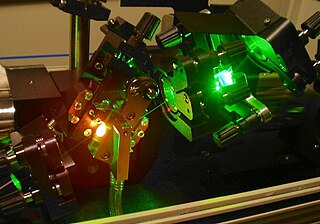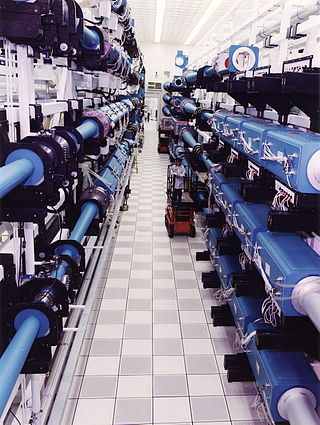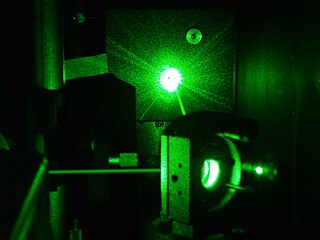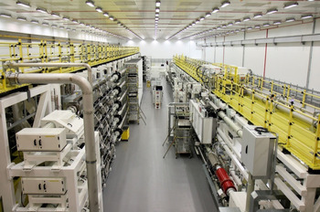Related Research Articles

A laser is a device that emits light through a process of optical amplification based on the stimulated emission of electromagnetic radiation. The word laser is an anacronym that originated as an acronym for light amplification by stimulated emission of radiation. The first laser was built in 1960 by Theodore Maiman at Hughes Research Laboratories, based on theoretical work by Charles H. Townes and Arthur Leonard Schawlow.
Q-switching, sometimes known as giant pulse formation or Q-spoiling, is a technique by which a laser can be made to produce a pulsed output beam. The technique allows the production of light pulses with extremely high (gigawatt) peak power, much higher than would be produced by the same laser if it were operating in a continuous wave mode. Compared to modelocking, another technique for pulse generation with lasers, Q-switching leads to much lower pulse repetition rates, much higher pulse energies, and much longer pulse durations. The two techniques are sometimes applied together.

A dye laser is a laser that uses an organic dye as the lasing medium, usually as a liquid solution. Compared to gases and most solid state lasing media, a dye can usually be used for a much wider range of wavelengths, often spanning 50 to 100 nanometers or more. The wide bandwidth makes them particularly suitable for tunable lasers and pulsed lasers. The dye rhodamine 6G, for example, can be tuned from 635 nm (orangish-red) to 560 nm (greenish-yellow), and produce pulses as short as 16 femtoseconds. Moreover, the dye can be replaced by another type in order to generate an even broader range of wavelengths with the same laser, from the near-infrared to the near-ultraviolet, although this usually requires replacing other optical components in the laser as well, such as dielectric mirrors or pump lasers.

Ti:sapphire lasers (also known as Ti:Al2O3 lasers, titanium-sapphire lasers, or Ti:sapphs) are tunable lasers which emit red and near-infrared light in the range from 650 to 1100 nanometers. These lasers are mainly used in scientific research because of their tunability and their ability to generate ultrashort pulses thanks to its broad light emission spectrum. Lasers based on Ti:sapphire were first constructed and invented in June 1982 by Peter Moulton at the MIT Lincoln Laboratory.
Chirped pulse amplification (CPA) is a technique for amplifying an ultrashort laser pulse up to the petawatt level, with the laser pulse being stretched out temporally and spectrally, then amplified, and then compressed again. The stretching and compression uses devices that ensure that the different color components of the pulse travel different distances.

Nova was a high-power laser built at the Lawrence Livermore National Laboratory (LLNL) in California, United States, in 1984 which conducted advanced inertial confinement fusion (ICF) experiments until its dismantling in 1999. Nova was the first ICF experiment built with the intention of reaching "ignition", a chain reaction of nuclear fusion that releases a large amount of energy. Although Nova failed in this goal, the data it generated clearly defined the problem as being mostly a result of Rayleigh–Taylor instability, leading to the design of the National Ignition Facility, Nova's successor. Nova also generated considerable amounts of data on high-density matter physics, regardless of the lack of ignition, which is useful both in fusion power and nuclear weapons research.

Laser pumping is the act of energy transfer from an external source into the gain medium of a laser. The energy is absorbed in the medium, producing excited states in its atoms. When for a period of time the number of particles in one excited state exceeds the number of particles in the ground state or a less-excited state, population inversion is achieved. In this condition, the mechanism of stimulated emission can take place and the medium can act as a laser or an optical amplifier. The pump power must be higher than the lasing threshold of the laser.

A ruby laser is a solid-state laser that uses a synthetic ruby crystal as its gain medium. The first working laser was a ruby laser made by Theodore H. "Ted" Maiman at Hughes Research Laboratories on May 16, 1960.
Laser Mégajoule (LMJ) is a large laser-based inertial confinement fusion (ICF) research device near Bordeaux, France, built by the French nuclear science directorate, Commissariat à l'Énergie Atomique (CEA).
The Gekko XII Laser (激光XII号レーザー) is a high-power, 12-beam, neodymium-doped glass laser at the Osaka University's Institute for Laser Engineering (大阪大学レーザーエネルギー学研究センター) completed in 1983, which is used for high energy density physics and inertial confinement fusion research. The name refers to the twelve individual beamlines used to amplify the laser energy.

The High Power laser Energy Research facility (HiPER), is a proposed experimental laser-driven inertial confinement fusion (ICF) device undergoing preliminary design for possible construction in the European Union. As of 2019, the effort appears to be inactive.

The Vulcan laser is an infrared, 8-beam, petawatt neodymium glass laser at the Rutherford Appleton Laboratory's Central Laser Facility in Oxfordshire, United Kingdom. It was the facility's first operational laser.

In laser science, an output coupler (OC) is the component of an optical resonator that allows the extraction of a portion of the light from the laser's intracavity beam. An output coupler most often consists of a partially reflective mirror, allowing a certain portion of the intracavity beam to transmit through. Other methods include the use of almost-totally reflective mirrors at each end of the cavity, emitting the beam either by focusing it into a small hole drilled in the center of one mirror, or by redirecting through the use of rotating mirrors, prisms, or other optical devices, causing the beam to bypass one of the end mirrors at a given time.
LULI : Laboratoire pour l'Utilisation des Lasers Intenses (LULI) is a scientific research laboratory specialised in the study of plasmas generated by laser-matter interaction at high intensities and their applications. The main missions of LULI include: (i) Research in Plasma Physics, (ii) Development and operation of high-power high-energy lasers and experimental facilities, (iii) student formation in Plasma Physics, Optics and Laser Physics.

The Trident Laser was a high power, sub-petawatt class, solid-state laser facility located at Los Alamos National Laboratory, in Los Alamos, New Mexico, originally built in the late 1980s for Inertial confinement fusion (ICF) research by KMS Fusion, founded by Kip Siegel, in Ann Arbor, Michigan, it was later moved to Los Alamos in the early 1990s to be used in ICF and materials research. The Trident Laser has been decommissioned, with final experiments in 2017, and is now in storage at the University of Texas at Austin.

The Extreme Light Infrastructure is a research organization with the world's largest collection of high power-lasers. ELI operates several high-power, high-repetition-rate laser systems which enable the research of physical, chemical, materials, and medical sciences.

The Helmholtz-Zentrum Dresden-Rossendorf (HZDR) is a Dresden-based research laboratory. It conducts research in three of the Helmholtz Association's areas: materials, health, and energy. HZDR is a member of the Helmholtz Association of German Research Centres.

The Breit–Wheeler process or Breit–Wheeler pair production is a proposed physical process in which a positron–electron pair is created from the collision of two photons. It is the simplest mechanism by which pure light can be potentially transformed into matter. The process can take the form γ γ′ → e+ e− where γ and γ′ are two light quanta.
Pulsed operation of lasers refers to any laser not classified as continuous wave, so that the optical power appears in pulses of some duration at some repetition rate. This encompasses a wide range of technologies addressing a number of different motivations. Some lasers are pulsed simply because they cannot be run in continuous mode.

The Orion Laser Facility is a high power laser facility based at the Atomic Weapons Establishment (AWE) on the former RAF Aldermaston site in the United Kingdom.
References
- 1 2 3 M.H. Key 1985 Nucl. Fusion 25 1351 , doi:10.1088/0029-5515/25/9/063.
- 1 2 3 4 "High Intensity Laser Physics: Recent Results and Developments at the Central Laser Facility, UK," , asers and Electro-Optics - Pacific Rim, 2007. CLEO/Pacific Rim 2007. Conference on , vol., no., pp.1,2, 26-31 Aug. 2007doi: 10.1109/CLEOPR.2007.4391130.
- ↑ "Central Laser Facility-CALTA". Archived from the original on 2013-06-17. Retrieved 2013-06-10.
- ↑ New Director of the Central Laser Facility, Optics & Laser Technology, Volume 29, Issue 3, April 1997, Page v, ISSN 0030-3992, 10.1016/S0030-3992(97)82698-9.
- ↑ "The Central Laser Facility-Laser facility". Archived from the original on 2013-06-16. Retrieved 2013-06-07.
- ↑ "Kvaerner Behind The Heart Of Vulcan Laser." Professional Engineering 15.20 (2002): 52. Academic Search Complete. Web. 6 June 2013.
- ↑ "Commissioning the Astra Gemini petawatt Ti:sapphire laser system,", Lasers and Electro-Optics, 2008 and 2008 Conference on Quantum Electronics and Laser Science. CLEO/QELS 2008. Conference on , vol., no., pp.1,2, 4–9 May 2008.
- ↑ "Artemis". STFC Central Laser Facility. UKRI. Archived from the original on 4 November 2020. Retrieved 4 November 2020.
- ↑ "Central Laser facility-ULTRA". Archived from the original on 2013-02-10. Retrieved 2013-06-07.
- ↑ "Central Laser Facility-OCTOPUS". Archived from the original on 2013-06-17. Retrieved 2013-06-10.
- ↑ Helen Lock, "STFC lab wins major Czech contract", Times Higher Education, 12 April 2013.
- ↑ "HiLASE". HiLASE. Archived from the original on 1 November 2020. Retrieved 4 November 2020.
- ↑ HiPER-Laser energy for the future
- ↑ Relativistic electron mirrors from nanoscale foils for coherent frequency upshift to the extreme ultraviolet, Nature Communications 4, Article number: 1763 doi:10.1038/ncomms2775.
- ↑ "Central Laser Facility-DiPOLE". Archived from the original on 2015-09-23. Retrieved 2013-06-10.